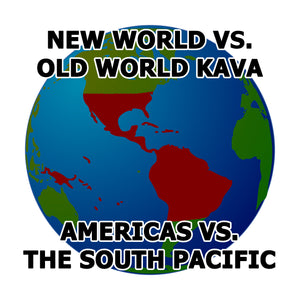When it comes to kava, the traditional drink of the South Pacific, it's fascinating to explore how its cultivation, flavors, and effects differ between its place of origin and the Americas. In this article, we'll delve into the four key distinctions between Old World (South Pacific) kava and (New World) North and South American kava.

1. Terroir:
In the South Pacific, kava plants thrive in the rich volcanic soils and tropical climate, contributing to the unique terroir of the region. The combination of fertile soil, ample rainfall, and year-round warmth imparts distinct characteristics to the kava roots. On the other hand, North and South American kava is cultivated in diverse environments, ranging from the continental climate of the United States to the milder climates of Costa Rica and Puerto Rico. This variation in terroir results in different flavor profiles and nuances in American kava.

2. Cultivation Techniques:
South Pacific kava has a long history of traditional cultivation practices, passed down through generations. The Pacific islanders employ organic farming methods, relying on natural fertilizers and manual harvesting techniques. In contrast, American kava cultivation often involves a blend of traditional methods and modern agricultural practices. Due to the diverse climates and growing conditions, farmers adapt their techniques accordingly, resulting in slight variations in the cultivation process.

3. Cultivar Varieties:
In the South Pacific, various kava cultivars have been cultivated over millennia, each with its own unique characteristics. The most famous cultivars coming from Vanuatu, Fiji, and Tonga, are renowned for their distinct flavor profiles and effects. In the Americas, kava enthusiasts have introduced these traditional cultivars, while also experimenting with new hybrid varieties like Kali Kava. This advancement of traditional cultivars has led to an expanding array of options for kava lovers, offering a diverse range of flavors and experiences.

4. Cultural Heritage:
Kava holds deep cultural significance in the South Pacific, where it plays a central role in social gatherings, ceremonies, and traditional rituals. The reverence for kava is ingrained in the cultural fabric of the region, and its consumption is accompanied by specific customs and protocols. In North America, kava has gained popularity as an alternative beverage, valued for its relaxing properties and potential health benefits. While the cultural context may differ, the appreciation for kava and its unique qualities remains a common thread that connects enthusiasts across continents.

Conclusion:
Exploring the differences between Old World (South Pacific) and New World (American) kava reveals the diverse flavors, cultivation techniques, and cultural contexts associated with this cherished beverage. Whether you prefer the traditional flavors of the South Pacific or the evolving varieties cultivated in the Americas, the world of kava offers a rich tapestry of experiences to discover and enjoy.

What type of kava do you prefer? Enjoy new world and old world kava made with the AluBall Kava Maker.

